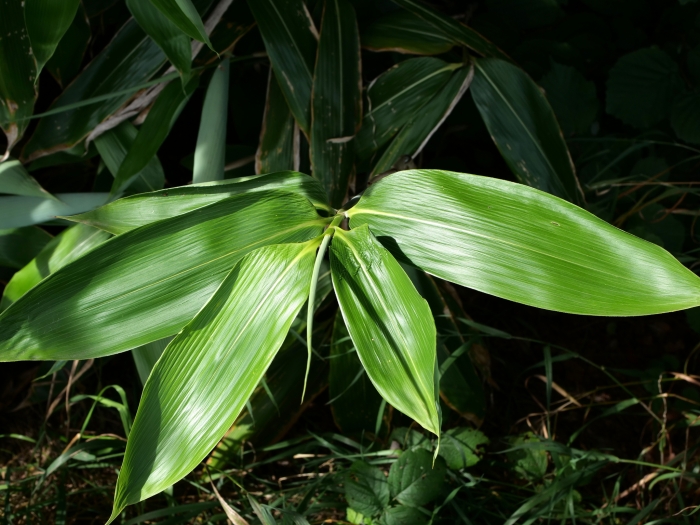Broadleaf Bamboo
(Sasa palmata)
Broadleaf Bamboo (Sasa palmata)
/
/

Wolfgang Jauch
CC BY 4.0
Image By:
Wolfgang Jauch
Recorded By:
Copyright:
CC BY 4.0
Copyright Notice:
Photo by: Wolfgang Jauch | License Type: CC BY 4.0 | License URL: http://creativecommons.org/licenses/by/4.0/ | Rights Holder: Wolfgang Jauch | Publisher: iNaturalist | Date Created: 2023-08-08T11:53:05-07:00 |

























Estimated Native Range
Summary
Sasa palmata, commonly known as broadleaf bamboo or broad-leaved bamboo, is a perennial herbaceous bamboo native to the cool temperate forests of Japan and Korea. It is a shade-tolerant species that typically thrives in the understory of forests, often forming dense thickets. Sasa palmata can reach up to 7 feet in height and is characterized by its large, broad leaves which can be up to a foot long, providing a lush, tropical appearance. The plant does not commonly flower, and when it does, the flowers are not particularly showy.
Broadleaf bamboo is valued for its ability to form a dense ground cover quickly, which makes it an excellent choice for erosion control and for creating a green understory in woodland gardens. It is also used as a privacy screen due to its height and foliage density. In cultivation, Sasa palmata prefers moist, well-drained soils and can tolerate a range of light conditions from full shade to partial sun. While it is relatively low maintenance, it can become invasive outside its native range, spreading through rhizomes. Gardeners should consider containment strategies or choose clumping bamboo varieties to avoid unwanted spread.CC BY-SA 4.0
Broadleaf bamboo is valued for its ability to form a dense ground cover quickly, which makes it an excellent choice for erosion control and for creating a green understory in woodland gardens. It is also used as a privacy screen due to its height and foliage density. In cultivation, Sasa palmata prefers moist, well-drained soils and can tolerate a range of light conditions from full shade to partial sun. While it is relatively low maintenance, it can become invasive outside its native range, spreading through rhizomes. Gardeners should consider containment strategies or choose clumping bamboo varieties to avoid unwanted spread.CC BY-SA 4.0
Plant Description
- Plant Type: Grass
- Height: 4-8 feet
- Width: 4-6 feet
- Growth Rate: Rapid
- Flower Color: N/A
- Flowering Season: Non-Flowering
- Leaf Retention: Evergreen
Growth Requirements
- Sun: Full Sun, Part Shade
- Water: Medium
- Drainage: Medium
Common Uses
Low Maintenance
Natural Habitat
native to the cool temperate forests of Japan and Korea
Other Names
Common Names: Palmata Bamboo , Broadleaf Bamboo , Palmate Bamboo , Chimaki-Zasa , Sato-Chimaki , Neba-zasa
Scientific Names: Sasa palmata , Arundinaria palmata , Arundinaria palmata , Arundinaria palmata f. nebulosa , Arundinaria paniculata f. chimakisasa , Arundinaria paniculata f. nebulosa , Arundinaria paniculata var. nebulosa , Bambusa ontakensis , Bambusa palmata , Bambusa palmata
GBIF Accepted Name: